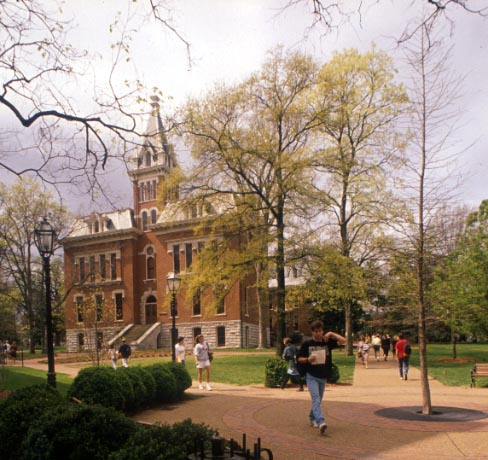Ghost Trees: The champion September elm

The national champion September elm stood on the north side of Benson Hall. This photo was taken in 1985 as part of a Nashville Banner article on Tennessee’s Big Tree Register on September 16, 1985.
Nashville Banner article posted with permission of the copyright holder, The Nashville Public Library Special Collections Division: Nashville Banner Archives
As part of the effort for the Vanderbilt campus to gain the status of an official arboretum (see the arboretum history), an effort was made to identify significant trees on campus for recognition as
state or national champions. To assess the size of the trees, the circumference in inches, height in feet, and 1/4 the crown spread in feet were summed and the trees with the greatest value of this index were granted champion status.
One of the trees so recognized was a large September elm that grew on the north side of Benson Hall. September elms are an endemic species that is most common in middle Tennessee and is only found naturally in the states that surround Tennessee. September elms are virtually identical to the more widespread American elm except that they bloom in the fall rather than in the early spring as is the case for American elms. In 1985, Vanderbilt’s tree was listed as a co-champion on the national list, the only Vanderbilt tree to ever achieve this status. In 2001 it had a circumference of 91 inches, height of 90 feet, and crown spread of 68 feet, giving it a total score of 198 points.

September elms by Benson Science Hall, c. 1995. The former champion tree can be seen at the near right corner of the building. The largest surviving September elm on campus can be seen just to the left of the building.
Source: Vanderbilt University Special Collections and University Archives photo cs0320
Sometime between 1995 and 2005, the champion elm died and was removed. The current national champion grows at the entrance of Warner Parks Nature Center and has a circumference of 135 inches, height of 83 feet, and crown spread of 77 feet (total points: 237), although the ghost Vanderbilt tree is still listed on the Tennessee state register. Vanderbilt’s biggest surviving
September elm has a circumference of only 103 inches and crown spread of about 67 feet, but at about 98 feet it is taller than the current champion (total points: about 218). It is also healthier than the champ, so it may be waiting in the wings to take its place as champion at some point in the future. In any case, it is one of the largest known examples of its species in the world.
Back to Ghost Trees